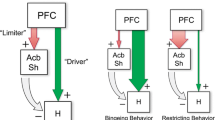Abstract.
Rationale: Endogenous opioids have been implicated in the hedonic evaluation of food and palatability. Opioids may also be involved in alcohol intake, as there is a positive correlation between alcohol drinking and preference for sweets and fats. Our previous studies have shown that mu opioid stimulation of the nucleus accumbens preferentially augments intake of palatable food containing sucrose and fat. Objective: The first goal of the present study was to further explore the nature of the involvement of mu opioids within the nucleus accumbens in ingestive behavior by investigating the importance of orosensory reward in opioid-mediated feeding, using non-caloric tasty substances (saccharin and salt). Second, we investigated whether mu opioid receptors within the nucleus accumbens also regulate alcohol consumption. Methods: The mu agonist, D-Ala2, NMe-Phe4, Glyol5-enkephalin (DAMGO; 0, 0.025 and 0.25 µg/0.5 µl per side), was microinfused into the nucleus accumbens, and intake of 0.6% saline, 0.15% sodium saccharin, water, and 6% ethanol was measured. Results: Microinfusion of DAMGO into the nucleus accumbens increased the drinking of salt and saccharin solutions in non-deprived rats. However, water intake was not increased by this treatment in water-deprived rats. Mu opioid stimulation of the nucleus accumbens also augmented ethanol intake in rats not deprived of fluid, while leaving water intake unchanged when water was concurrently available. Conclusion: These results provide evidence to suggest that the mu opioid system within the ventral striatum regulates ingestive behavior via a mechanism related to the hedonic assessment of taste. In addition, the nucleus accumbens may be a key brain area where ethanol interacts with endogenous opioid systems, and thus may be a common neural substrate for both food palatability and alcohol drinking.
Similar content being viewed by others
Author information
Authors and Affiliations
Additional information
Electronic Publication
Rights and permissions
About this article
Cite this article
Zhang, M., Kelley, A.E. Intake of saccharin, salt, and ethanol solutions is increased by infusion of a mu opioid agonist into the nucleus accumbens. Psychopharmacology 159, 415–423 (2002). https://doi.org/10.1007/s00213-001-0932-y
Received:
Accepted:
Issue Date:
DOI: https://doi.org/10.1007/s00213-001-0932-y




